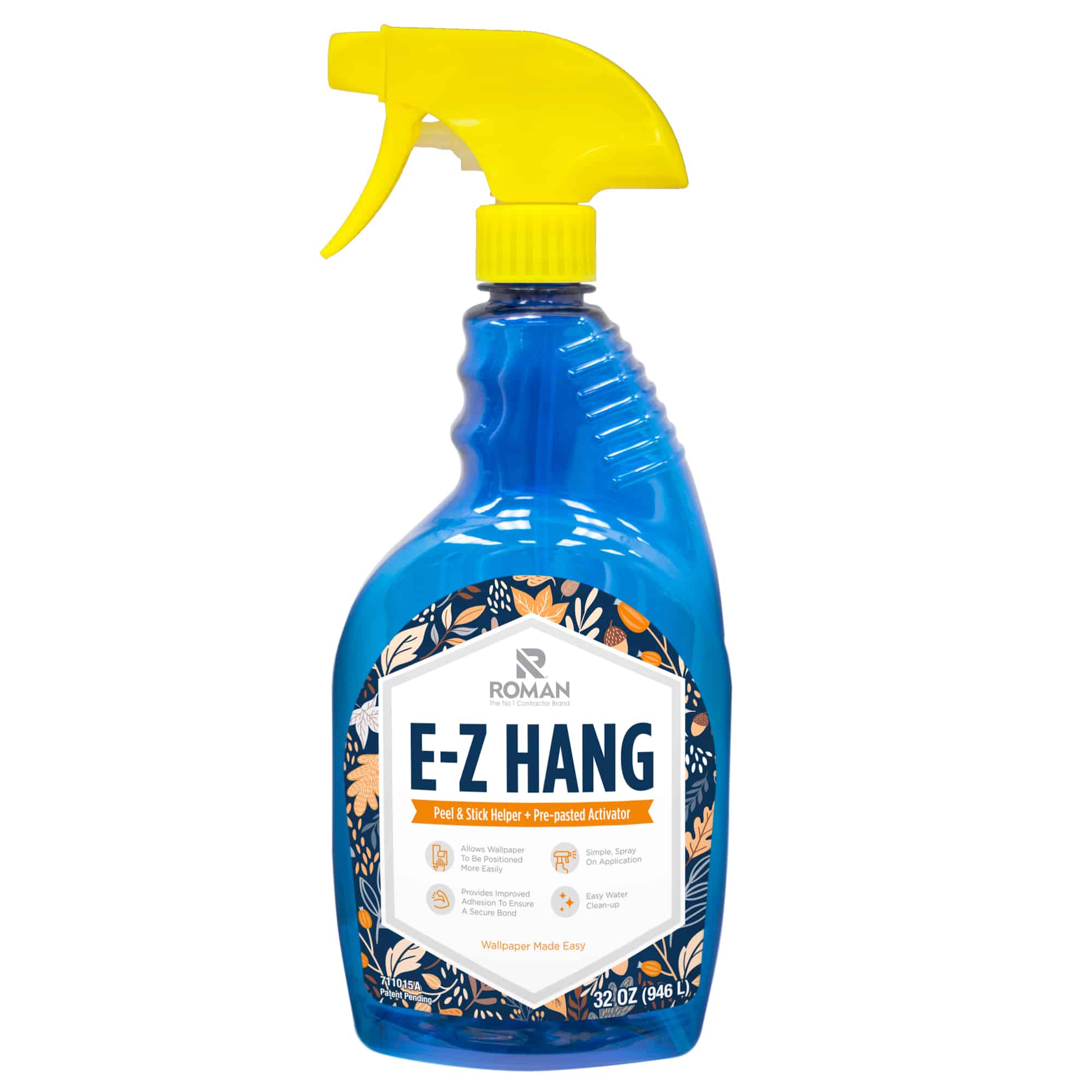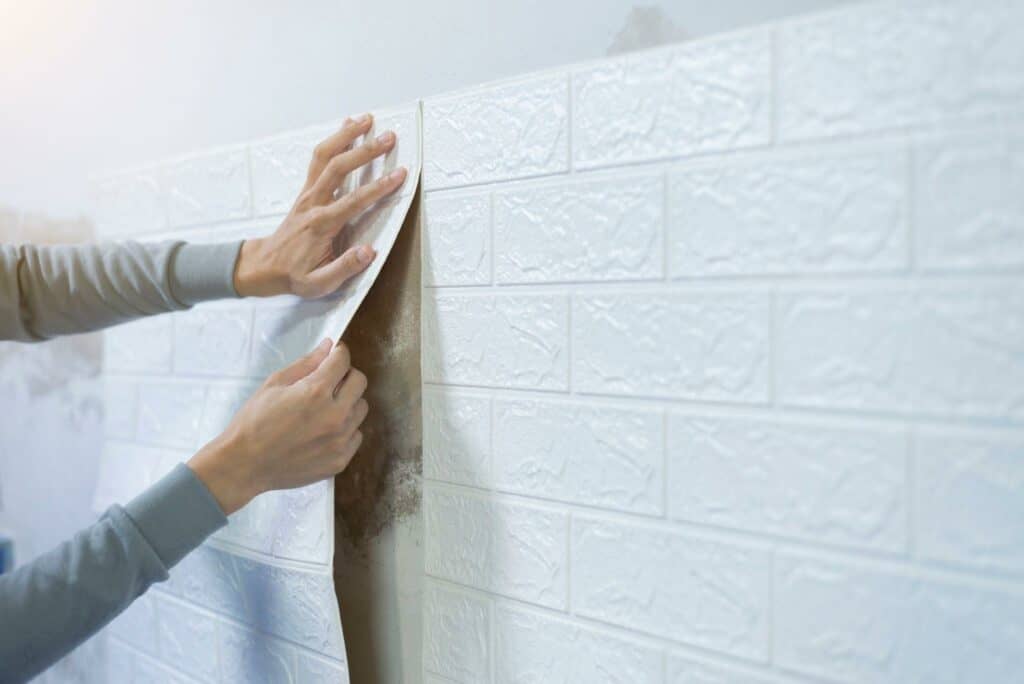Peel and stick wallpaper is widely valued for its ease of use and versatility in home decor. But it’s also true that many people have experienced issues with their peel and stick wallpaper not sticking properly or even falling off over time.
If you’ve faced this frustrating problem, don’t worry—you’re not alone. In this article, we will explore the reasons behind peel and stick wallpaper failures and offer effective solutions to ensure your wallpaper stays in place. Along the way, we’ll introduce you to ROMAN’s E-Z Hang Peel & Stick Helper + Pre-Pasted Activator. This is a very handy spray adhesive for peel and stick wallpaper that can make your next wallpaper installation a breeze.
Why Does Peel & Stick Wallpaper Fail?
Before diving into solutions, let’s understand why peel and stick wallpaper might not adhere as expected. Several factors can contribute to this issue:
Textured Walls

Walls finished with an orange peel, knockdown, or other textured finish can present challenges when using removable peel and stick wallpaper. The voids left by the texture can create pockets of poor adhesion, making it difficult for the wallpaper to stick securely.
If you have lightly textured walls, using an adhesive spray like ROMAN’s E-Z Hang Peel & Stick Helper may improve adhesion. However, for surfaces with heavy texture, a more comprehensive solution is required. Applying a skim coat to smooth out the surface before wallpaper installation is recommended. This process ensures a flat and even surface for the adhesive to grip onto.
Humidity
Areas with high humidity, such as bathrooms and kitchens, are more prone to peel and stick wallpaper adhesion failures. When hot, moist air accumulates in a room, it can soften the adhesive used in peel and stick wallpaper. Over time, this softening effect may lead to wallpaper peeling or opening at the seams. To avoid this issue, consider these tips:
- Ensure the room is adequately ventilated to reduce humidity buildup.
- Use an exhaust fan or open a window while showering or cooking to help dissipate moisture.
- Opt for peel and stick wallpapers specifically designed for high-humidity environments, as they often have stronger adhesives and water-resistant properties.
Temperature Changes
Extreme temperature fluctuations, such as rapid shifts from cold to hot or vice versa, can impact the performance of peel and stick wallpaper. As the wallpaper warms up, it expands, and as it cools down, it contracts. Over time, these cycles of expansion and contraction may weaken the wallpaper’s bond to the wall, leading to adhesion failure. To minimize the impact of temperature changes:
- Maintain a stable indoor temperature within a reasonable range to reduce the stress on the wallpaper.
- Avoid placing peel and stick wallpaper in areas directly exposed to intense sunlight or sources of extreme heat, as this can worsen temperature-related issues.
- Consider using a wallpaper smoother or roller during installation to ensure optimal adhesion, especially in areas prone to temperature fluctuations.
By addressing these factors, you can significantly enhance the longevity and adhesion of your peel and stick wallpaper. Whether it’s preparing textured walls, managing humidity, or regulating temperature changes, taking the time to learn how to make peel and stick wallpaper stick better can really pay off in the long run.
How to Fix It
Now let’s explore some effective peel and stick wallpaper tips to address these issues and ensure your wallcoverings can adhere securely. Here are step-by-step instructions to help you fix peeling or poorly adhered wallpaper:
1. Peel Back the Paper
If you notice areas of your peel and stick wallpaper that are not adhering properly or have begun to peel, the first step is to address these trouble spots. Gently peel back the loose paper until you reach a section that is still well adhered to the wall. Take care not to damage the wallpaper during this process.
2. Clean the Wall
Once you’ve exposed the well-adhered section of the wall, it’s essential to clean the wall surface thoroughly. Use a light-grade cleaning solution to wash away any residue or contaminants from the wall. This step ensures a clean and smooth surface for the wallpaper to adhere to. Allow the wall surface ample time to dry completely before proceeding.
3. Apply E-Z Hang Peel & Stick Helper

ROMAN’s E-Z Hang Peel & Stick Helper is a valuable tool for enhancing the adhesion of your wallpaper. Spray a generous amount of E-Z Hang Peel & Stick Helper onto the cleaned and dry wall surface.
E-Z Hang provides peel and stick wallpaper with extra adhesion for a long-lasting, durable bond, which can prevent many of the common adhesion issues faced with removable wallpaper. It also provides “slip,” which enables the installer to float the material into position without needing to keep peeling and re-sticking it to the surface.
4. Smooth the Wallpaper
With the E-Z Hang Peel & Stick Helper applied to the wall, carefully reposition and smooth out the peeling or poorly adhered wallpaper section. Start from the center of the paper and work outward towards the seams. Use a plastic smoothing tool to ensure there are no air bubbles or wrinkles. This will help you create a smooth and secure bond between the wallpaper and the wall surface.
5. Clean Excess Adhesive
After successfully reattaching the wallpaper and smoothing it out, be sure to clean up any excess E-Z Hang Peel & Stick Helper that may have squeezed out along the seams. The excess adhesive can be easily wiped away with a wet rag or sponge.
By following these steps, you can prevent the all-too-common headache of peel and stick wallpaper falling off. ROMAN’s E-Z Hang Peel & Stick Helper + Pre-Pasted Activator can enhance the adhesive bond, making the entire process smoother. Say goodbye to peeling wallpaper, and enjoy a beautiful, long-lasting wallcovering in your home.




